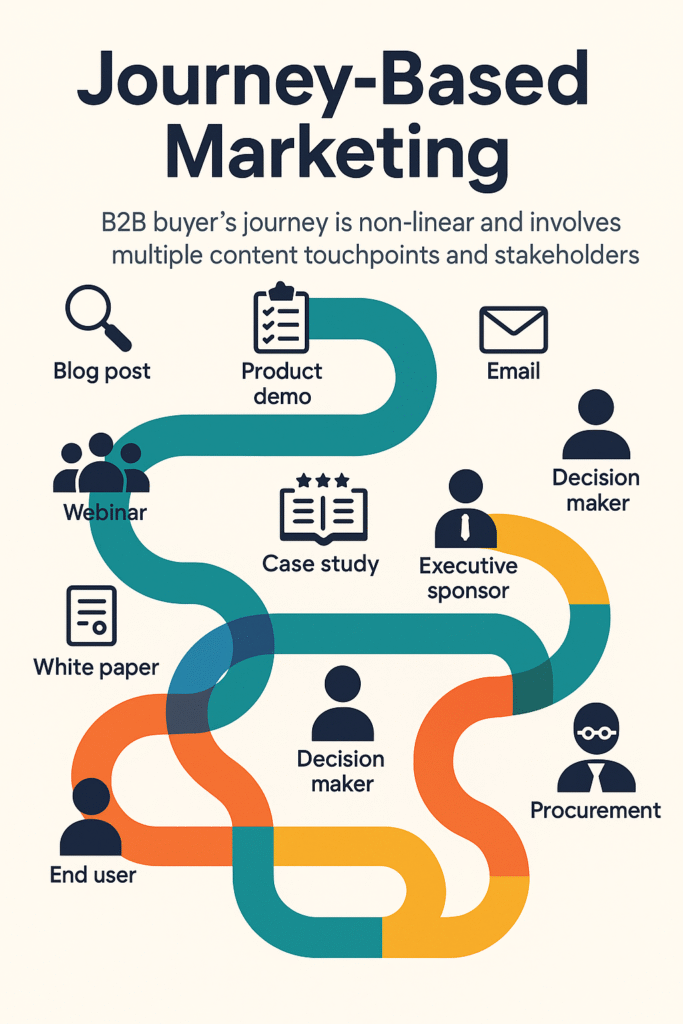The B2B buyer’s journey isn’t linear anymore. Your prospects don’t follow neat, predictable paths from awareness to consideration to decision. They zigzag across channels, revisit content at random intervals, and make purchasing decisions with input from multiple stakeholders who each consume different types of content.
This reality has fundamentally changed how we need to think about content strategy. The old playbook of creating awareness-stage blog posts, consideration-stage whitepapers, and decision-stage case studies isn’t enough. Today’s most successful B2B marketers are embracing journey-based marketing—a strategic approach that maps content to the actual, messy reality of how buyers move through their purchasing process.

The Death of the Linear Funnel
Traditional funnel thinking assumes prospects move through stages in sequence: they become aware of a problem, research solutions, evaluate vendors, and make a purchase. Content was created and distributed accordingly, with each piece serving a specific funnel stage.
But modern B2B buying doesn’t work this way. Research from Gartner shows that B2B buyers spend only 17% of their time meeting with potential suppliers when considering a purchase. The rest? They’re consuming content independently, often jumping between different stages of the journey based on immediate needs, stakeholder input, or external triggers.
Consider this scenario: A marketing director discovers your brand through a LinkedIn post (awareness), immediately downloads a detailed implementation guide (decision-stage content), shares it with their team, then circles back weeks later to read introductory blog posts to better understand the broader context (back to awareness). This isn’t unusual—it’s the new normal.
What Journey-Based Marketing Really Means
Journey-based marketing flips the script. Instead of organizing content around funnel stages, it focuses on mapping and supporting the actual paths your buyers take. It recognizes that different personas within the same organization will have different information needs, consumption preferences, and decision-making timelines.
A content journey strategy acknowledges that your CFO stakeholder might only engage with ROI calculators and case studies, while your end-user champion wants tactical how-to content and product demos. Both are part of the same buying decision, but they’re on completely different content paths.
The key shift is moving from “What stage is this prospect in?” to “What job is this content helping them do right now?” This job-to-be-done lens helps you create content that’s genuinely useful regardless of where someone officially sits in your funnel.
Mapping Your Content Touchpoints
The foundation of effective journey-based marketing is understanding your actual content touchpoints—every interaction a prospect has with your brand across all channels and formats. This goes far beyond your owned properties to include social media interactions, third-party review sites, industry publications, peer recommendations, and even competitor comparisons.
Start by conducting a comprehensive touchpoint audit. Interview recent customers to understand their actual discovery and evaluation process. What content did they consume? In what order? Which pieces were most influential? What gaps did they encounter? This research often reveals surprising patterns that challenge assumptions about buyer behavior.
Map these touchpoints across three dimensions:
Channel diversity: Where are prospects actually finding and consuming your content? This might include your blog, LinkedIn, industry publications, podcast appearances, webinars, peer review sites, and even conversations with your sales team.
Content variety: What formats and topics are resonating at different points? This includes everything from social posts and blog articles to demos, case studies, tools, templates, and informal conversations.
Stakeholder complexity: Who else is involved in the decision, and what content do they need? Technical evaluators need different information than budget approvers, and both are different from end users.
Building Content That Connects the Dots
With your touchpoint map in hand, you can start building content that supports the actual buyer journey rather than an idealized funnel. This requires a fundamental shift in content planning and creation.
Create content clusters, not isolated pieces. Instead of standalone blog posts, develop interconnected content experiences that allow prospects to go deeper on topics that matter to them. A cluster might include a high-level overview post, detailed implementation guides, video walkthroughs, templates, and case studies—all linked together and easy to navigate.
Design for non-linear consumption. Every piece of content should work as both an entry point and a continuation of the journey. Include sufficient context so someone discovering your content for the first time can understand it, while providing clear next steps for those ready to go deeper.
Address the full stakeholder ecosystem. Create content that speaks to different roles within the buying committee. This might mean developing technical documentation for evaluators, ROI frameworks for budget approvers, and change management resources for implementation teams—all for the same solution.
Build in wayfinding and progression. Make it easy for prospects to find related content and understand their options for engaging further. This might include content recommendation engines, resource hubs organized by topic or role, or clear calls-to-action that guide next steps.
The Operational Side of Journey-Based Content
Implementing a content journey strategy requires operational changes beyond just content creation. Your measurement, distribution, and optimization approaches all need to evolve.
Measurement shifts from attribution to contribution. Instead of trying to assign credit to individual touchpoints, focus on understanding how different content pieces contribute to overall buyer progression and decision quality. This might mean tracking content consumption patterns, engagement depth, and stakeholder involvement rather than just conversion rates.
Distribution becomes orchestrated, not scattered. Rather than pushing all content through all channels, thoughtfully sequence and coordinate how content appears across touchpoints. This might mean using social media to amplify blog content, email to surface relevant resources based on past engagement, or sales teams to share specific pieces at appropriate conversation moments.
Optimization happens at the journey level, not just the asset level. While individual content performance matters, the bigger opportunity is optimizing how pieces work together. This might mean testing different content sequences, improving transitions between related pieces, or experimenting with different stakeholder-specific pathways.
Common Pitfalls and How to Avoid Them
Journey-based marketing isn’t without challenges. Here are the most common mistakes and how to sidestep them:
Over-complicating the initial approach. Start simple by mapping one or two key buyer personas and their typical content consumption patterns. Build complexity gradually rather than trying to account for every possible path upfront.
Neglecting the sales and customer success handoff. Your content journey shouldn’t end at purchase. Consider how content supports onboarding, adoption, expansion, and advocacy. These post-purchase touchpoints often influence future buying decisions and referrals.
Creating content in silos. Journey-based content works best when different teams collaborate. Blog content should connect to sales resources, which should align with customer onboarding materials, which should tie back to product marketing positioning.
Forgetting about content discoverability. Even the best content fails if prospects can’t find it when they need it. Invest in search optimization, internal linking strategies, and content organization that makes sense from the buyer’s perspective, not just your internal structure.
Making the Transition
Moving from traditional funnel-based content marketing to journey-based marketing doesn’t happen overnight. Start by identifying your highest-value buyer personas and mapping their typical content consumption patterns. Focus on creating connected content experiences for these priority segments before expanding to other audiences.
Audit your existing content library to identify gaps and opportunities for better connection between pieces. Often, you already have most of the content you need—it just needs better organization and linking to support buyer journeys.
Test and iterate based on actual buyer feedback. The most successful journey-based content strategies evolve based on real-world data about how prospects actually engage with content, not just theoretical buyer journey maps.
The Competitive Advantage of Journey-Thinking
Companies that master journey-based marketing create a significant competitive advantage. They build deeper relationships with prospects by providing genuinely helpful content experiences rather than just promotional materials. They involve more stakeholders in the buying process by addressing diverse information needs. And they create more qualified pipeline by helping prospects thoroughly understand and prepare for their purchase decision.
Most importantly, they build trust by demonstrating understanding of their buyers’ actual challenges and decision-making processes. In a world where buyers are increasingly skeptical of marketing messages, this trust becomes a crucial differentiator.
The future belongs to marketers who can think beyond the funnel and design content experiences that truly serve their buyers’ journeys. The question isn’t whether to make this transition—it’s how quickly you can start.
Ready to transform your content strategy? Start by mapping one key buyer persona’s actual content consumption journey. Interview recent customers, audit your existing touchpoints, and identify your biggest content connection opportunities. The insights will surprise you—and the competitive advantage will be worth the effort.

